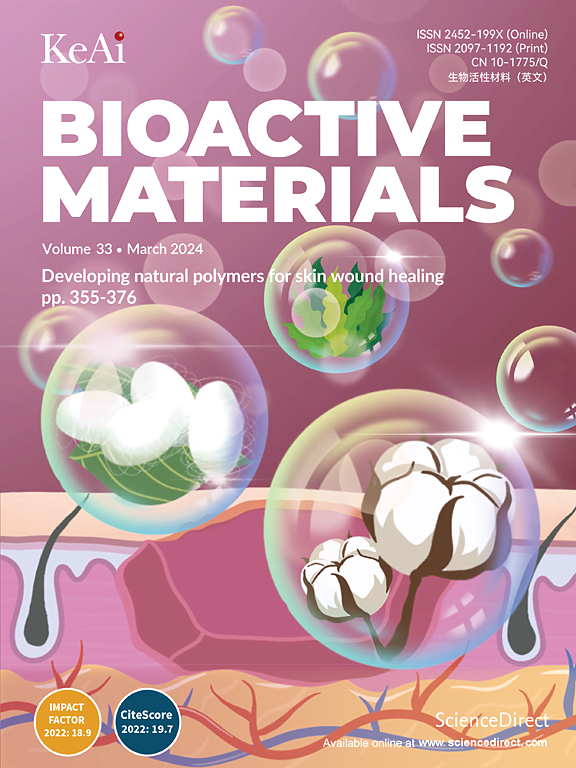肿瘤酸中毒的实时磁共振显像作为治疗效果的预知指标
IF 18
1区 医学
Q1 ENGINEERING, BIOMEDICAL
引用次数: 0
摘要
传统的抗肿瘤策略往往需要足够的时间来根据肿瘤结构的变化来评估有效性。一旦无效,患者可能会错过寻求替代治疗方案的关键窗口期。本文研制了一种载质子泵抑制剂(PPI)的硫化锰纳米平台。该纳米平台旨在通过磁共振成像(MRI)可视化肿瘤酸中毒程度,实现实时疗效预知。该纳米平台在肿瘤细胞的酸性溶酶体中释放PPI、H2S和Mn2+。PPI抑制V-ATPase表达,导致细胞内H+水平升高。H2S加速肿瘤细胞对葡萄糖的消耗,产生更多的乳酸,进一步诱发肿瘤酸中毒。肿瘤酸中毒反过来加速纳米平台的降解,获得更高的肿瘤MRI。由于肿瘤酸中毒程度与肿瘤消退呈正相关,因此酸中毒程度的实时可视化可以有效预测未来的治疗方法。有趣的是,肿瘤酸中毒可以有效抑制肿瘤转移,而不是增加肿瘤转移。总的来说,这项工作提出了一个能够实时可视化肿瘤酸中毒的纳米平台,并精确预测未来的治疗方法。本文章由计算机程序翻译,如有差异,请以英文原文为准。

Real-time magnetic resonance visualization of tumor acidosis as a precognition indicator of therapeutic efficacy
Traditional antitumor strategies often require sufficient time to assess the effectiveness according to changes in tumor structure. Once ineffective, patients may miss the critical window for pursuing alternative treatment options. Herein, a manganese sulfide nanoplatform loaded with proton pump inhibitor (PPI) is developed. This nanoplatform is designed for visualizing tumor acidosis degree by magnetic resonance imaging (MRI), achieving real-time therapeutic efficacy precognition. The nanoplatform releases PPI, H2S, and Mn2+ within the acidic lysosome of tumor cells. PPI inhibits V-ATPase expression, leading to an increase in intracellular H+ levels. H2S accelerates glucose consumption of tumor cells, producing more lactic acid and further inducing tumor acidosis. Tumor acidosis in turn accelerates the nanoplatform's degradation, achieving higher tumor MRI. As the tumor acidosis degree correlates positively with tumor regression, real-time visualization of acidosis degree effectively predicts future therapeutics. Interestingly, tumor acidosis achieves efficient tumor metastasis suppression rather than increases it. Overall, this work presents a nanoplatform capable of visualizing tumor acidosis in real-time and precisely predicting future therapeutics.
求助全文
通过发布文献求助,成功后即可免费获取论文全文。
去求助
来源期刊

Bioactive Materials
Biochemistry, Genetics and Molecular Biology-Biotechnology
CiteScore
28.00
自引率
6.30%
发文量
436
审稿时长
20 days
期刊介绍:
Bioactive Materials is a peer-reviewed research publication that focuses on advancements in bioactive materials. The journal accepts research papers, reviews, and rapid communications in the field of next-generation biomaterials that interact with cells, tissues, and organs in various living organisms.
The primary goal of Bioactive Materials is to promote the science and engineering of biomaterials that exhibit adaptiveness to the biological environment. These materials are specifically designed to stimulate or direct appropriate cell and tissue responses or regulate interactions with microorganisms.
The journal covers a wide range of bioactive materials, including those that are engineered or designed in terms of their physical form (e.g. particulate, fiber), topology (e.g. porosity, surface roughness), or dimensions (ranging from macro to nano-scales). Contributions are sought from the following categories of bioactive materials:
Bioactive metals and alloys
Bioactive inorganics: ceramics, glasses, and carbon-based materials
Bioactive polymers and gels
Bioactive materials derived from natural sources
Bioactive composites
These materials find applications in human and veterinary medicine, such as implants, tissue engineering scaffolds, cell/drug/gene carriers, as well as imaging and sensing devices.
 求助内容:
求助内容: 应助结果提醒方式:
应助结果提醒方式:


